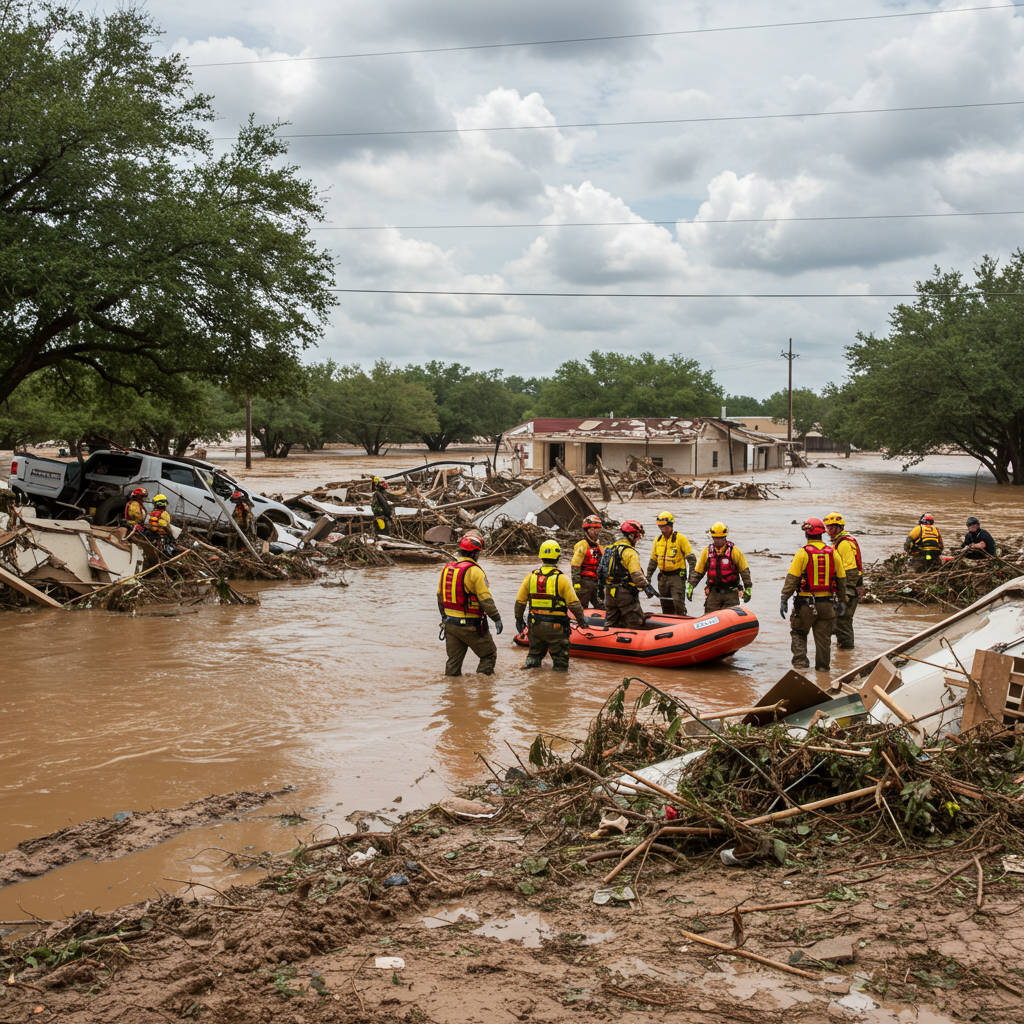Catastrophic flash flooding in central texas has resulted in a devastating human toll, with the confirmed death count tragically reaching at least 78 as of Sunday, July 7, 2025. Among the deceased are at least 28 children, caught in the sudden and powerful surge of floodwaters that struck the region around the US Independence Day holiday. As search efforts continue for dozens still missing, including several children from a beloved summer camp, fears remain high for renewed flooding as saturated grounds face ongoing rainfall.
Unprecedented Devastation Grips Texas Hill Country
The impact of the floods has been most severe in Kerr County, located within the picturesque Texas Hill Country. According to Kerr County Sheriff Larry Leitha, the county alone accounts for 68 fatalities, a figure that includes the 28 young lives lost. The scale of the disaster prompted Texas Governor Greg Abbott to tour the affected areas and address the unfolding tragedy. Governor Abbott confirmed the statewide death toll stood at a minimum of 78 by Sunday afternoon and reported that 41 individuals were still officially listed as missing across Texas.
The rapid rise of water levels was particularly shocking. Torrential rain began falling on Friday, July 4th, saturating the ground and causing rivers like the nearby Guadalupe River to break their banks with alarming speed. In some areas, river levels surged as high as 29 feet (9 meters), driving an immense volume of water across the landscape. The storm systems dumped up to 15 inches (38 cm) of rain in parts of the region, located about 85 miles (140 km) northwest of San Antonio.
Search Continues Amid Hope and Fear
The search for survivors and victims is now in its third day, presenting immense challenges for rescue teams. Officials reported that by Saturday, over 850 people had been rescued from precarious situations, including some who were found clinging to trees for safety. However, the mission remains critical, especially with the significant number of people still unaccounted for.
Adding complexity and danger to the search efforts are the persistent weather threats. Texas Division of Emergency Management Chief Nim Kidd warned that ongoing rain falling on already saturated soil increases the risk of further flash flooding. He specifically mentioned unconfirmed reports of an “additional wall of water” moving through creeks within the Guadalupe River watershed. In response to these threats, rescue personnel working near the river have been alerted to potentially pull back from hazardous areas, and aircraft have been deployed to scout for new flood surges.
Tragedy Strikes a Historic Summer Camp
Among the most heartbreaking impacts of the flooding was the devastation at Camp Mystic, a Christian girls’ summer camp with nearly a century of history. Located near the Guadalupe River, the camp was severely impacted by the rising waters. Sheriff Leitha confirmed that as of Sunday, 10 Camp Mystic campers and one counselor remained missing.
Governor Abbott described the scenes he witnessed during his tour of the camp and surrounding areas as “nothing short of horrific.” Eyewitness accounts from counselors painted a vivid picture of the terrifying night. Katharine Somerville, a counselor on the higher-ground Cypress Lake side of Camp Mystic, recounted how even their cabins, situated atop hills, were completely flooded, losing power in the middle of the night. Her 13-year-old campers were understandably scared by the sudden and unexpected inundation. Somerville confirmed her group was safely evacuated via military trucks.
Photos and reports from the camp detail the extent of the physical destruction. Inside one cabin, mud lines clearly showed the water had risen at least six feet (1.83 meters) from the floor. Bed frames, mattresses, and personal belongings were caked in mud and scattered throughout the buildings. Some structures suffered broken windows, and one cabin was missing an entire wall, illustrating the sheer force of the floodwaters.
Federal Response and Questions Over Preparedness
In response to the disaster, President Donald Trump issued a major disaster declaration, activating the Federal Emergency Management Agency (FEMA). FEMA is deploying crucial resources to support first responders on the ground. The U.S. Coast Guard is also actively involved, providing essential helicopter and plane support for search and rescue missions. President Trump extended his condolences to the victims, calling the event “absolutely horrible,” and announced plans to visit the disaster site, likely on Friday. His administration confirmed they were in contact with Governor Abbott.
However, the disaster has also brought to light questions regarding the federal government’s preparedness and response capabilities, particularly concerning weather prediction. Some experts have raised concerns about the potential impact of workforce reductions within federal agencies overseeing the National Weather Service. Former NOAA director Rick Spinrad noted that thousands of job cuts under the current administration have left many weather offices understaffed, stating this would inevitably degrade forecasting ability, although he could not definitively link it to the lack of advance warning for this specific event.
Homeland Security Secretary Kristi Noem acknowledged that a “moderate” flood watch issued by the National Weather Service on Thursday did not accurately predict the extreme rainfall that followed. She stated the Trump administration was working to upgrade the weather prediction system. Democratic U.S. Congressman Joaquin Castro from Texas echoed concerns about reduced personnel potentially hindering accurate analysis and predictions crucial in flash flooding situations, suggesting it “could lead to tragedy.” President Trump, when asked about whether federal cuts impacted the response, deflected, referencing the previous administration’s setup but calling the flood a “100-year catastrophe.”
The coming days will remain critical as search efforts continue and affected communities begin the long process of assessing damage and recovery from this devastating natural disaster. The focus remains on finding those still missing and providing support to the victims and their families in the wake of this unprecedented event.
Frequently Asked Questions
What is the current death toll and number of missing people from the Texas floods?
As of Sunday, July 7, 2025, the confirmed death toll from the catastrophic Texas floods stands at least 78 people, including a minimum of 28 children. Additionally, 41 individuals across the state remain officially listed as missing. The majority of deaths occurred in Kerr County.
Where was the most significant impact of the flooding felt?
The most devastating impact was concentrated in Kerr County, part of the Texas Hill Country, which alone reported 68 fatalities. A summer camp, Camp Mystic, located near the Guadalupe River in this area, was severely affected, with 10 campers and one counselor still missing from that location.
What caused the extreme and sudden flooding in Texas?
The rapid and severe flooding was caused by a sudden storm system that moved through central Texas on Friday, July 4th. This storm dumped up to 15 inches (38 cm) of rain on already saturated ground. The torrential rainfall caused the Guadalupe River and other waterways to break their banks rapidly, with river levels rising as much as 29 feet (9 meters) in a short period, leading to dangerous flash floods.
How is the government responding to the Texas flood disaster?
Both state and federal agencies are involved in the response. Texas Governor Greg Abbott has been on the ground assessing the situation. President Donald Trump issued a major disaster declaration, enabling FEMA to deploy resources for search and rescue operations. The U.S. Coast Guard is also providing helicopter and aircraft support. Rescue teams have already saved over 850 people, but search efforts are ongoing, complicated by the potential for further flash flooding.
Conclusion
The Texas floods of July 2025 represent a profound tragedy, leaving a trail of death, destruction, and heartbreak across the central part of the state. With a death toll of at least 78, including a significant number of children, and dozens still missing, families and communities face immense grief and uncertainty. The devastation at places like Camp Mystic underscores the swift and merciless nature of the flash flooding. As search and rescue operations continue despite challenging conditions and the threat of more rain, state and federal agencies are working to support affected areas. The disaster has also sparked important discussions about disaster preparedness and the accuracy of weather forecasting in the face of increasingly intense weather events. The focus now remains on supporting victims, locating the missing, and beginning the long and difficult process of recovery.
Word Count Check: ~1150 words



